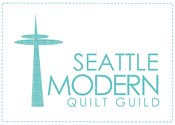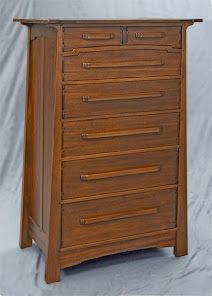I make great quilt binding. I learned how to do it years ago, and am amazed at how many quiltmakers don't know how easy it is. So here it is, step-by-step.
Start with about 3/4 of a yard of good quality quilter's cotton fabric. Cut off the selvages and cut a 45 degree angle across the fabric, from selvage to selvage (or where they used to be). Somewhere in the middle, it doesn't really matter. Line the 45 degree line on your ruler with the bottom edge of the fabric. You may have to use two rulers to go from edge to edge. If so, line them up precisely and be very careful when you cut by where they meet. You don't want to run your blade into the corner of the ruler.
Here is how it should look after you cut the 45 degree angle:
If you cut your fabric face-up (which I didn't) then you can flip one side over on top of the other and line up the straight sides, right sides together. Like this:
Take them to your machine and sew a quarter-inch seam allowance along that straight side:
Press seam open. This is very important. All the seams in a binding must be pressed open. It helps to eliminate the bulk.
At this point you should have a large parallelogram. The top and bottom are straight, and the right and left sides are at a 45 degree angle, going the same way.
Back at your large table, using your see-thru ruler, make a line using any kind of marking tool. I usually use a pencil, ink pen or Pigma marker. It really doesn't matter, because you are marking a cutting line and it will not be seen. But it needs to stay on until you cut and be easy-to-see. Starting on one of the diagonal sides make lines 2-1/4" apart all the way across to the other side. I like my bindings tight, if you want yours bigger or looser then make your marks 2-1/2" apart:
When you reach the other side and can't fit another line on, cut off the excess where you would have made your line:
If you look really hard at this photo, you can see the pencil lines, 2-1/4" apart across the whole piece:
Okay, here's the weirdest part. Now we are going to sew right-sides-together on the long straight sides, making a tube of sorts. BUT! When we line up the sides, slide one side over by one marked row. So, you want to put a pin, 1/4" (seam allowance) down from the edge, through the marked line one the front piece and into the marked line on the other piece, in back, down 1/4" right through the line. Do this for each line. When you are done, the last line should be right at the end of the other fabric end:
And, you will have a twisted, odd shaped tube of sorts:
Sew a 1/4" seam allowance along where you just pinned. You are seaming together two bias edges, so it will be stretchy. Be gentle, and do not stretch or tug. The seam will gently curve around, but you'll hardly notice:
Sew right up to the pin before you remove it:
When finished you will have an odd tube-shaped thingy. Press open the seam you just sewed. This is tricky, you don't want to press unwanted lines into the rest of the tube. Take your time and turn and straighten the tube as you go:
Okay, now the tedious part, cutting it apart. You can't use a rotary cutter. Get out your good old Ginghers. Start cutting on the line you drew. Since you offset it by one row, it is now on big long continuous line. And around and around you go:
Cut and cut and cut some more.
Back at the ironing board, fold the strip in half, wrong sides together, and iron the whole long thing. Again, keeping in mind that this is now all bias-cut and very stretchy. Do not stretch it out of shape.
You now have enough binding for a large quilt, a queen-sized anyway. When you start the binding on the quilt, leave about a 12" tail to facilitate when joining up the other end, once you come around. It usually doesn't matter where you start on the quilt with a normal binding. Put the raw side of the binding on the outside edge of the quilt sandwich on the topside and sew it on using a walking foot and sewing 1/4" from the edge. On my walking foot, that means the outside edge is actually hanging off the edge a little bit. Throw all that binding into the middle of the quilt (it helps to have enough table to support all that quilt) and here we go:
When you get to a corner, sew up to 1/4" from the edge and stop and backstitch a few stitches.
Take your needle out and remove the quilt from under the foot. You don't have to cut the threads. Turn the quilt to the next edge.
Fold the binding up and away from you. It will make a 45 degree angle on the corner of the quilt. Finger press that perfect little angle in there.
Then fold the binding down, back towards you, so the fold lines up with the top edge of the quilt. This is critical, not too much, not too little. You want it to line up right on the edge.
Then start sewing, 1/4" from the edge and 1/4" from the top. Take a stitch or two and then backstitch. Continue on your way.
You will have three more corners to practice on. After the fourth corner, judge how far it is to where you started. Sew up to a point where you are leaving at least 6 to 12" inches from the end of the tail you left loose at the beginning. Here you will need to stop, remove the quilt from the machine.
Lay the two ends over each other, with the beginning, short end, on top. Open them both up and mark where the short one overlaps the long one. Use a pencil or pen that you can see, but that won't bleed through.
After you get the binding all sewn on, then iron it over, all the way around. Don't mess with the corners, though.
Lay the two ends over each other, with the beginning, short end, on top. Open them both up and mark where the short one overlaps the long one. Use a pencil or pen that you can see, but that won't bleed through.
Then take your ruler, line up the 45 degree line with the bottom of the binding and mark another line 1/2" (two seam allowances) to the outside (making it longer) than the first line. So, what you are doing is adding in the seam allowances for when you sew the two ends together.
Then cut on the second line, making sure there will be a 1/2" overlap with the other end.
Then putting right sides together, sew the two ends together. See the picture below. The 'dog ears' should hang over each end about a quarter of an inch down. If you start sewing right in the intersection they will line up straight when you open them up.
Once the two ends are sewn together, they should be the correct length with the quilt. Finger press, or iron, the seam open and fold over. Then finish sewing the binding to the quilt.
Cut the dog ears off to eliminate bulk.
Then working from the back hand-sew the binding down. I use cotton thread and a good straw needle. Use no more than a 24" section of thread. You can start anywhere on the quilt, it doesn't matter. But, may I suggest you start after a corner, so you have a long way to your first corner and get the stitching down to a science before you get there.
I work differently than most. I sew towards myself. There are valid reasons for this. I think it's more ergonomically correct and it's easier to see where your needle is going.
(These instructions are for right-handers, and yes I know how frustrating this is to lefties, my husband being one).
So, with the edge of the quilt on your left, put your knotted thread through the quilt back under where the binding will cover it. I go in, come out and then knot the thread again to the back (all under where the binding will go. Then come up through the back of the binding, just catching a few of the threads on the edge. Make sure the binding is starting out straight and flat and then put your thread straight down into the backing, through the quilt and come up a fat eighth of an inch closer to you. Then up through the binding catching, again, just a few of the threads of the edge. Then straight down into the back...etc.
When you come to a corner, continue sewing the binding down, straight out to the edge. At this point I put another knot in, even though I have thread left on my neeedle, and then continue sewing with that thread.
Turn the quilt over and come up on the front, and put 2 to 3 stitches in to hold the mitered corner together.
Then flip back over to the back, fold the binding and make your mitered corner as good as you can before you take any stitches. Use your needle to help push the fabric underneath back and flat. Place 2 to 3 stitches along the miter and then continue on your way around the quilt. You'll have three more corners to get it right!
When you come to the end of your thread, come up under the binding and knot it off in the backing. Leave the tail, as it will be hidden under the binding. Re-thread your needle and knot it and anchor it into the backing under the binding again. And off you go.
Have fun.







































No comments:
Post a Comment